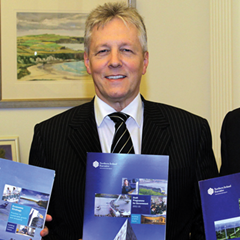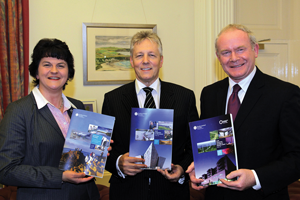 After a disappointing start, devolution has to deliver in this Assembly term. Peter Cheney scrutinises the draft Programme for Government.
After a disappointing start, devolution has to deliver in this Assembly term. Peter Cheney scrutinises the draft Programme for Government.
Ministers have insisted they will deliver on the new Programme for Government, after a poor track record over the last four years. However, the process has already been dominated by delay with the draft published six months after the May election.
A final version will only be ready after 22 February 2012, when consultation ends.
Northern Ireland’s grindingly slow political system compares badly with direct rule. Furthermore, the province risks being left far behind as global competitors recover from the recession.
This draft Programme for Government was published later than the 2007 version (17 November compared to 27 October). Scotland had its final programme on 7 September and Wales on 27 September. The current UK and Irish Governments both agreed their programmes in nine days.
The DUP and Sinn Féin claim that the process is harder in a five-party Executive but it was reasonable to expect more speed after four years’ experience in government.
Significantly, the legislative programme, setting out exactly what laws the Executive will introduce, is missing. Ian Paisley and Martin McGuinness published this alongside the draft in 2007 but ministers are still working on it. Northern Ireland is currently the only part of the British Isles without one.
Delivery on the last Programme for Government was modest at best. An official progress report up to 30 September 2010 showed that just six out of 66 promises had been fully kept:
• free public transport for over 60s;
• a careers advice service for disabled people;
• the Project Kelvin telecoms link to America and Europe;
• introducing employment and support allowance;
• central Belfast’s new sewer project; and
• helping “up to 4,700” farmers meet the Nitrates Directive by 2009 (DARD offered 4,360 grants and 3,933 farmers completed projects).
In addition, the Executive froze the regional rate, streamlined the Health Service and stopped water charges. The programme’s key failures, partly caused by the recession, included:
• a rise in child poverty (after an unrealistic target to halve it in two years);
• no single education authority (originally due in 2009);
• no merger of local councils (due by 2011); and
• the delayed Belfast rapid transit project (where work was due to start this year).
Forty-four per cent apathy in the Assembly poll was interpreted as a sign of contentment by some MLAs but clearly indicated falling interest in Stormont.
Introducing the programme, Peter Robinson focused on economics and integration while McGuinness took up its themes on poverty and the environment.
Robinson called for the “full and enthusiastic participation and support of people across society, including the public, private and voluntary sectors” but later added that this was “not a fixed and final document” with room for improvement.
The deputy First Minister said that all politicians had to raise their game on the economy, and equality was a key factor in economic growth. McGuinness looked forward to seeing more “shared spaces” and promised to bring forward labour-intensive schemes in the accompanying Investment Strategy.
McGuinness had just run for the presidency of Ireland but the programme contains no plans to expand the North/South Ministerial Council. A review started in July 2007, following the
St Andrews Agreement, and decisions are due in June 2012.
The stamp of the Civil Service is clear in the language. Many issues will be addressed rather than problems solved. Ministers mentioned a child poverty reduction pilot study, non-departmental members of stakeholder forums, and interventions to deal with multi-generational poverty.
agendaNi provides a full analysis of the document over the following pages.
Tom Elliott said that the UUP had stayed the course on corporation tax while other political reactions to that policy “ranged from lukewarm to sceptical to downright hostile”. Alasdair McDonnell questioned what a “poverty outcomes model” would mean on the Shankill, Falls and Lower Newtownards roads.
David Ford championed it as a “major improvement on previous programmes for government”. The debate, though, was limited by a lack of opposition.
Alliance can take some credit for the shared future focus in the document but its decision to enter the Executive leaves the Assembly with three opposition MLAs to 105 in government.
Jim Allister sensed “politburo politics” as Speaker William Hay only allowed questions from government parties. OFMDFM confirmed that impression by refusing to respond to criticism from Allister or Steven Agnew. Their parties represent 22,511 voters.
For the record, Allister would have asked why the public should have confidence in the programme given the “unmet targets and undelivered promises” in the last one.
Agnew welcomed the aim to cut CO2 emissions by 35 per cent by 2025, but noted that this was the lowest target for any UK region. He questioned the Executive’s commitment after cutting funding to the Carbon Trust, which advises businesses on reducing CO2 emissions.
“Too little, too late, too slow and too timid” was ICTU’s dismissive verdict.
“There is no grand vision and little hope for thousands of families across Northern Ireland,” said its Assistant General Secretary Peter Bunting. He called for ministers to put more pressure on UK Government to change course, and questioned when the economy would be a resignation issue.
On the opposite side of the political spectrum, the Northern Ireland Conservatives described the document as a “marketing exercise … much of which consists of old announcements which have been repackaged.”
The debate will continue over the next two months but time is short and the public expects results.
Once the final programme is signed off, the Executive has three years to prove it can bring about real change for Northern Ireland residents facing increasing hardship.






